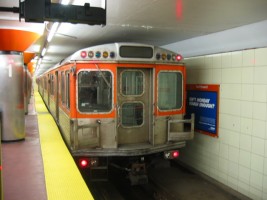 M-4 1118
M-4 1118
Location: 46th Street Station, Philadelphia, PA
Operator of Vehicle: Southeastern Pennsylvania Transit Authority (SEPTA)
Date of Photo: June 27, 2001
Last week, SEPTA awarded a contract to Hitachi Rail for 200 railcars for its Market-Frankford Line, by far the busiest line in the Philadelphia transit network. These cars are scheduled to be delivered between 2029 and 2031, replacing the existing fleet of M-4 cars seen here. The M-4 cars were quite advanced at the time they were introduced, as they included features such as AC traction motors, interior LCDs to display the next stop and automated announcements. Also, unlike most newer subway trains, they retained a full railfan window at the front of the train. Now that these cars are over 25 years old, SEPTA has started the process of replacing them with what will be known as the M-5 cars. From the renderings that SEPTA has made public, the cars will probably feel somewhat similar to the 8000 Series cars that Hitachi is currently building for WMATA, as the M-5s will feature open gangways, longitudinal seating, and designated spaces for bicycles, strollers, and luggage.
Believe it or not, I am sharing a 23 year old photo of the M-4s because it is among the most recent photos I have of rolling stock on the Market-Frankford Line! So if you’ve been like me and haven’t been on an M-4 in awhile (or even if you have been on one more recently), make sure to get some last rides in over the next 5 years or so!
For more photos of the SEPTA Market-Frankford Line, please click here.

